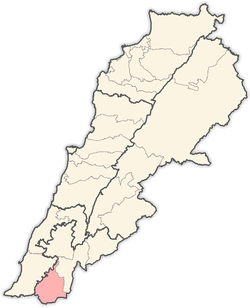Aynata
| Aynata عيناتا | |
|---|---|
| Village | |
 Aynata Location within Lebanon | |
| Coordinates: 33°7′43.68″N 35°26′6.36″E / 33.1288000°N 35.4351000°ECoordinates: 33°7′43.68″N 35°26′6.36″E / 33.1288000°N 35.4351000°E | |
| Grid position | 191/281 PAL |
| Country |
|
| Governorate | Nabatieh Governorate |
| District | Bint Jbeil District |
| Elevation | 740 m (2,430 ft) |
| Time zone | EET (UTC+2) |
| • Summer (DST) | EEST (UTC+3) |
Aynata (عيناتا)[1] is a village in Lebanon. It is located in the southern portion of the country.[2] A stronghold for Hezbollah, during the war with Israel in 2006, about 60% of the homes in the town were destroyed.[3]
The terrain consists of plateaus of varying heights, with the Aynata itself located at an elevation of 740m. Several valleys separate Aynata from the nearest villages. Aynata has a moderate climate, cool summers and cold winters.
History
In 1596, it was named as a village, ‘’Aynata’’ in the Ottoman nahiya (subdistrict) of Tibnin under the liwa' (district) of Safad, with a population of 111 households and 22 bachelors, all Muslim. The villagers paid taxes on agricultural products, such as wheat, barley, vineyards, fruit trees, goats and beehives, in addition to "occasional revenues" and a fixed sum; a total of 10,560 akçe.[4][5]
In 1875, Victor Guérin found a village with 400 Metualis.[6]
In 1881, the Palestine Exploration Fund's Survey of Western Palestine (SWP) described it: "A village, built of stone, containing about 500 Metawileh. There is a Moslem school in the village; extensive vineyards and a few olives in the wady. Water supplied from birket and many cisterns.”[7]
Modern era
Aynata is the family home of Mohammad Hussein Fadlallah.
During the 2006 Lebanon War, on July 19, an Israeli missile killed 4 civilians in the village.[8] On July 24, Israel shelled two houses in the village; killing all inside both houses. One house had 4 Hizbollah fighters, the other house had 8 civilians, aged between 16 and 77.[9]
Aaynata has a population of around 5,000 (dropping to 1,300 in the winter) and is 120 kilometers (74.568 mi) away from Beirut and sits 740 meters above sea level. The area borders Bent Jbayl, Aaitaroun, and Yaroun.[10] It was occupied by Israel and most residents emigrated to Beirut’s southern suburbs. Israel pulled out of the area in 2000 and it has seen housing construction since that time.[10] Tobacco and olices are grown in the area.
References
- ↑ From personal name, according to Palmer 1881, p. 66
- ↑ Cambanis, Thanassis (16 August 2006). "Reclaiming bodies and shattered lives in Lebanon". The Boston Globe.
- ↑ Slackman, Michael (11 July 2007). "Where Outsiders, and Fear, Loom Over Daily Life". The New York Times.
- ↑ Hütteroth and Abdulfattah, 1977, p. 179
- ↑ Note that Rhode, 1979, p. 6 writes that the register that Hütteroth and Abdulfattah studied was not from 1595/6, but from 1548/9
- ↑ Guérin, 1880, p. 374
- ↑ Conder and Kitchener, 1881, SWP I, p. 200
- ↑ HRW, 2007, pp. 105-106
- ↑ HRW, 2007, pp. 112-113
- 1 2 Aaynata Localiban
Bibliography
- Conder, Claude Reignier; Kitchener, H. H. (1881). The Survey of Western Palestine: Memoirs of the Topography, Orography, Hydrography, and Archaeology. 1. London: Committee of the Palestine Exploration Fund.
- Guérin, Victor (1880). Description Géographique Historique et Archéologique de la Palestine (in French). 3: Galilee, pt. 2. Paris: L'Imprimerie Nationale.
- HRW (2007). Why They Died: Civilian Casualties in Lebanon During the 2006 War. Human Rights Watch.
- Hütteroth, Wolf-Dieter; Abdulfattah, Kamal (1977). Historical Geography of Palestine, Transjordan and Southern Syria in the Late 16th Century. Erlanger Geographische Arbeiten, Sonderband 5. Erlangen, Germany: Vorstand der Fränkischen Geographischen Gesellschaft. ISBN 3-920405-41-2.
- Palmer, E. H. (1881). The Survey of Western Palestine: Arabic and English Name Lists Collected During the Survey by Lieutenants Conder and Kitchener, R. E. Transliterated and Explained by E.H. Palmer. Committee of the Palestine Exploration Fund.
- Rhode, Harold (1979). Administration and Population of the Sancak of Safed in the Sixteenth Century. Columbia University.
External links
- Survey of Western Palestine, Map 4: IAA, Wikimedia commons
- Aaynata (Bent Jbeil), Localiban
